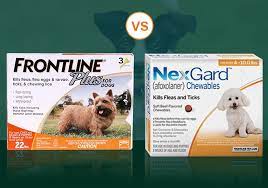Frontline vs Nexgard: Which One Is Better for Flea and Tick Prevention in Dogs?
If you are a dog owner, you know how important it is to protect your furry friend from fleas and ticks. These pesky parasites can cause a lot of problems for your dog, such as itching, irritation, infection, allergy, anemia, and disease transmission. Fortunately, there are many products available on the market that can help you prevent and treat flea and tick infestations in your dog. Two of the most popular and effective products are Frontline and Nexgard. But which one is better for your dog? In this article, we will compare and contrast Frontline and Nexgard in terms of their features, benefits, drawbacks, and suitability for different dogs. We will also provide some tips and advice on how to use them safely and effectively.
What are Frontline and Nexgard?
Frontline and Nexgard are both brand names of flea and tick prevention products for dogs. They are manufactured by different companies and have different modes of administration, ingredients, and mechanisms of action.
Frontline
Frontline is a topical solution that is applied directly to your dog’s skin, usually between the shoulder blades. It contains two active ingredients: fipronil and (S)-methoprene. Fipronil is an insecticide that kills adult fleas and ticks by disrupting their nervous system. (S)-methoprene is an insect growth regulator that prevents flea eggs and larvae from developing and hatching. Frontline works by spreading through the oil glands and hair follicles of your dog’s skin and coat, creating a protective barrier that lasts for up to 30 days. Frontline is available over the counter and comes in different formulations and sizes for different dogs.
Nexgard
Nexgard is an oral chew that is given to your dog once a month. It contains afoxolaner, a new molecule that belongs to the isoxazoline class of insecticides. Afoxolaner kills fleas and ticks by interfering with their nerve cells, causing paralysis and death. Nexgard works by entering your dog’s bloodstream and reaching the skin and hair, where it kills the pests that bite your dog. Nexgard is a prescription-only product and comes in different dosages for different dogs.
How do Frontline and Nexgard Compare?
Frontline and Nexgard are both effective and reliable products for flea and tick prevention in dogs. However, they also have some differences that may make one more suitable than the other for your dog’s needs and preferences. Here are some of the main criteria to consider when comparing Frontline and Nexgard:
1. Mode of administration
Frontline and Nexgard have different modes of administration, which may affect how easy or difficult they are to use and how well they work for your dog.
Frontline
Frontline is a topical solution that is applied to your dog’s skin. This means that you have to part your dog’s fur and squeeze the product onto the skin, making sure that it does not run off or get licked off by your dog. You also have to avoid touching or washing the treated area for at least 24 hours, and keep your dog away from children and other pets until the product dries. Some dogs may not like the sensation of the liquid on their skin, or may have allergic reactions to the ingredients. Some owners may also find it messy or inconvenient to apply the product every month.
Nexgard
Nexgard is an oral chew that is given to your dog by mouth. This means that you do not have to worry about applying the product correctly or avoiding contact with the treated area. You just have to make sure that your dog eats the whole chew and does not spit it out or vomit it up. Some dogs may love the taste of the chew, which is flavored with beef, while others may be picky or have difficulty chewing it. Some owners may also find it hard to remember to give the chew every month, or may not have a prescription from their vet.
2. Spectrum of action
Frontline and Nexgard have different spectrums of action, which means that they kill or repel different pests that may affect your dog.
Frontline
Frontline has a broad spectrum of action, as it kills fleas, ticks, and lice, and also prevents flea eggs and larvae from developing. Frontline is effective against the most common types of fleas and ticks that infest dogs in the U.S., such as the American dog tick, the brown dog tick, the deer tick, and the lone star tick. Frontline also kills chewing lice, which can cause skin irritation and hair loss in dogs.
Nexgard
Nexgard has a narrower spectrum of action, as it only kills fleas and ticks, and does not affect flea eggs and larvae or lice. Nexgard is also effective against the most common types of fleas and ticks that infest dogs in the U.S., but it also kills some other types of ticks that Frontline does not, such as the black-legged tick, the Gulf Coast tick, and the American dog tick. Nexgard does not kill lice, which may require a separate treatment if your dog has them.
3. Duration of effectiveness
Frontline and Nexgard have different durations of effectiveness, which means that they last for different periods of time before they need to be reapplied.
Frontline
Frontline lasts for up to 30 days, which means that you have to apply it every month to maintain its protection. Frontline provides continuous protection, as it remains on your dog’s skin and coat and kills the pests that come into contact with it. Frontline is also water-resistant, which means that it does not lose its effectiveness if your dog gets wet or swims. However, Frontline may lose some of its potency over time, especially if your dog has oily skin or is exposed to sunlight or high temperatures.
Nexgard
Nexgard lasts for up to 35 days, which means that you have to give it every month to maintain its protection. Nexgard provides intermittent protection, as it only kills the pests that bite your dog and does not repel them. Nexgard is also unaffected by water, sunlight, or temperature, as it works from the inside of your dog’s body. However, Nexgard may not work as well if your dog has a low body weight or a high metabolism, as it may not reach the optimal concentration in the bloodstream.
4. Safety and side effects
Frontline and Nexgard are both generally safe and well-tolerated by most dogs, but they may also have some side effects or adverse reactions that you should be aware of.
Frontline
Frontline is safe for use on dogs that are at least 8 weeks old and weigh at least 5 pounds. Frontline is also safe for use on pregnant, lactating, or breeding dogs. Frontline has a low risk of side effects, but some dogs may experience skin irritation, redness, itching, swelling, or hair loss at the application site. These reactions are usually mild and temporary, and resolve within a few days. However, if they persist or worsen, you should contact your vet. Frontline may also cause some systemic side effects, such as lethargy, vomiting, diarrhea, or seizures, in rare cases. These reactions are usually due to an overdose or an allergic reaction, and require immediate veterinary attention. Frontline may also interact with some other medications or treatments, such as ivermectin, so you should consult your vet before using it on your dog.
Nexgard
Nexgard is safe for use on dogs that are at least 8 weeks old and weigh at least 4 pounds. Nexgard is also safe for use on pregnant, lactating, or breeding dogs. Nexgard has a low risk of side effects, but some dogs may experience vomiting, diarrhea, lack of appetite, or lethargy after taking the chew. These reactions are usually mild and transient, and resolve within a few hours or days. However, if they persist or worsen, you should contact your vet. Nexgard may also cause some rare but serious side effects, such as seizures, tremors, ataxia, or anaphylaxis, in dogs. These reactions are usually due to an allergic or hypersensitivity reaction, and require immediate veterinary attention. Nexgard may also interact with some other medications or treatments, such as warfarin, so you should consult your vet before using it on your dog.
Cost and availability
Frontline and Nexgard have different costs and availability, which may affect your budget and convenience.
Frontline
Frontline is cheaper than Nexgard, as it costs around $10 to $15 per dose, depending on the size and formulation of the product. Frontline is also widely available over the counter, which means that you can buy it online or in stores without a prescription. However, Frontline may not be covered by your pet insurance, and you may have to pay out of pocket for it
Nexgard
Nexgard is more expensive than Frontline, as it costs around $20 to $25 per dose, depending on the dosage and quantity of the product. Nexgard is also a prescription-only product, which means that you need to get a prescription from your vet before you can buy it. However, Nexgard may be covered by your pet insurance, and you may be able to get discounts or rebates from the manufacturer.
Criteria | Frontline | Nexgard |
|---|---|---|
| Mode of administration | Topical solution applied to the skin | Oral chew given by mouth |
| Spectrum of action | Kills fleas, ticks, and lice, and prevents flea eggs and larvae from developing | Kills fleas and ticks, but does not affect flea eggs and larvae or lice |
| Duration of effectiveness | Lasts for up to 30 days, provides continuous protection, water-resistant | Lasts for up to 35 days, provides intermittent protection, unaffected by water, sunlight, or temperature |
| Safety and side effects | Safe for dogs over 8 weeks old and 5 pounds, low risk of skin irritation, possible systemic side effects, potential drug interactions | Safe for dogs over 8 weeks old and 4 pounds, low risk of vomiting, diarrhea, or lack of appetite, rare but serious side effects, possible drug interactions |
| Cost and availability | Cheaper, over-the-counter, may not be covered by pet insurance | More expensive, prescription-only, may be covered by pet insurance |
Conclusion: Frontline vs Nexgard
Frontline and Nexgard are both effective and reliable products for flea and tick prevention in dogs. However, they also have some differences that may make one more suitable than the other for your dog’s needs and preferences. Here are some of the pros and cons of each product:
- Frontline pros: Broad spectrum of action, continuous protection, water-resistant, cheaper, over-the-counter
- Frontline cons: Topical application, skin irritation, possible systemic side effects, potential loss of potency, possible drug interactions
- Nexgard pros: Oral administration, kills some additional ticks, unaffected by water, sunlight, or temperature, low risk of skin irritation, possible pet insurance coverage
- Nexgard cons: Narrower spectrum of action, intermittent protection, possible vomiting, diarrhea, or lack of appetite, rare but serious side effects, more expensive, prescription-only
Based on this comparison, you can decide which product is better for your dog. Some factors to consider are:
- Your dog’s size, weight, age, and health condition
- Your dog’s exposure to fleas and ticks and their life stages
- Your dog’s preference and tolerance for oral or topical products
- Your budget and convenience
- Your vet’s recommendation and prescription
Whatever product you choose, make sure to follow the instructions and precautions on the label and consult your vet if you have any questions or concerns. Also, remember that flea and tick prevention is not only about using products, but also about keeping your dog and your environment clean and pest-free. By doing so, you can ensure your dog’s health and happiness.
FAQS
Q: Which is better NexGard or Frontline?
Q: Is there something better than NexGard?
Q: What is the safest flea and tick medicine for dogs?
Q: Is there anything better than Frontline for dogs?
This depends on your dog’s needs and preferences, as well as the type and level of parasite infestation. Frontline is a topical solution that kills and repels fleas, ticks, and lice, and also prevents flea eggs and larvae from developing. It lasts for up to 30 days, is water-resistant, and is cheaper and over-the-counter. However, Frontline may cause skin irritation, lose some of its potency over time, and interact with some other medications. Some possible alternatives to Frontline are Revolution, NexGard, Bravecto, and K9 Advantix. Revolution is a topical solution that kills fleas, ticks, mites, and heartworms, and lasts for up to 30 days. It is prescription-only and may cause similar side effects as Frontline. NexGard and Bravecto are oral chews that kill fleas and ticks, and last for up to 35 days and 12 weeks, respectively. They are both prescription-only and more expensive than Frontline, and may cause rare but serious side effects such as seizures or allergic reactions. K9 Advantix is a topical solution that kills and repels fleas, ticks, mosquitoes, and lice, and lasts for up to 30 days. It is over-the-counter and water-resistant, but may cause skin irritation and interact with some other medications. You should consult your vet to find out which product is best for your dog.
Q: What are fleas and ticks and why are they harmful to dogs?
Fleas and ticks are external parasites that feed on the blood of dogs and other animals. They can cause itching, irritation, infection, allergy, anemia, and disease transmission in dogs. Some of the diseases that fleas and ticks can transmit to dogs include Lyme disease, Rocky Mountain spotted fever, ehrlichiosis, babesiosis, and tapeworms. Fleas and ticks can also infest your home and affect your family and other pets.
Q: How do Frontline and Nexgard work to prevent flea and tick infestations in dogs?
Frontline and Nexgard are both products that kill fleas and ticks that come into contact with your dog. Frontline is a topical solution that is applied to your dog’s skin and spreads through the oil glands and hair follicles, creating a protective barrier that lasts for up to 30 days. Nexgard is an oral chew that is given to your dog by mouth and enters the bloodstream, reaching the skin and hair, where it kills the pests that bite your dog. Both products have different active ingredients and mechanisms of action, but they are both effective and reliable.
Q: How often do I need to use Frontline or Nexgard on my dog?
You need to use Frontline or Nexgard on your dog every month to maintain their protection. Frontline lasts for up to 30 days, while Nexgard lasts for up to 35 days. However, you should always follow the instructions and precautions on the label and consult your vet before using any product on your dog.
Q: Are Frontline and Nexgard safe for my dog?
Frontline and Nexgard are both generally safe and well-tolerated by most dogs, but they may also have some side effects or adverse reactions that you should be aware of. Frontline may cause skin irritation, redness, itching, swelling, or hair loss at the application site, or systemic side effects such as lethargy, vomiting, diarrhea, or seizures in rare cases. Nexgard may cause vomiting, diarrhea, lack of appetite, or lethargy after taking the chew, or rare but serious side effects such as seizures, tremors, ataxia, or anaphylaxis in dogs. These reactions are usually due to an overdose or an allergic reaction, and require immediate veterinary attention. Frontline and Nexgard may also interact with some other medications or treatments, such as ivermectin or warfarin, so you should consult your vet before using them on your dog.
Q: How do I choose between Frontline and Nexgard for my dog?
There is no definitive answer to this question, as different dogs may have different needs and preferences. However, some factors to consider are:
- Your dog’s size, weight, age, and health condition
- Your dog’s exposure to fleas and ticks and their life stages
- Your dog’s preference and tolerance for oral or topical products
- Your budget and convenience
- Your vet’s recommendation and prescription
You should weigh the pros and cons of each product and decide which one is better for your dog. You can also try both products and see how your dog responds to them. Whatever product you choose, make sure to use it correctly and monitor your dog’s condition.
Related Posts
Are Dogs Allowed In CVS?
March 22, 2024• Dog
Are Dogs Allowed in Duane Reade?
March 22, 2024• Dog
Natural Dewormers for Dogs: Safe and Effective
March 15, 2024• Dog, Dog Health
How Do I Comfort My Dog After Neutering?
March 6, 2024• Dog, Dog Health
Dog Rubs Face on Carpet: A Guide to Why
March 5, 2024• Dog















ea reprehenderit eos nihil non nulla rerum porro architecto soluta aut. sequi nulla sed dolores eius sed quaerat ea accusamus ipsum. quis quia voluptatem nisi quos ut vitae porro quam voluptas saepe. quia et a voluptas laudantium nobis commodi nihil magnam ducimus doloremque ab sit in sunt consequuntur et. nemo doloribus sit sint officia ea aut nihil est rerum incidunt quia corrupti sed ratione qui sed adipisci.